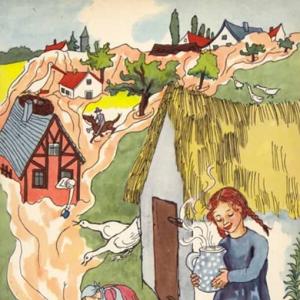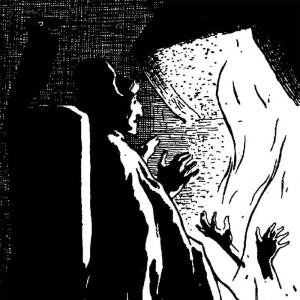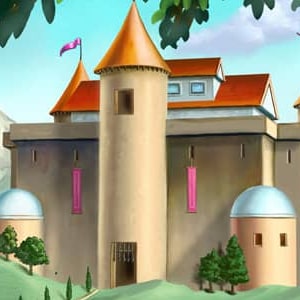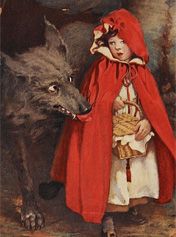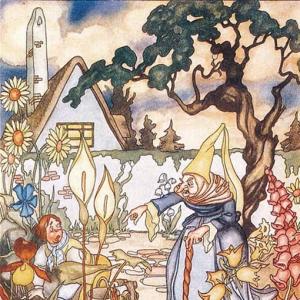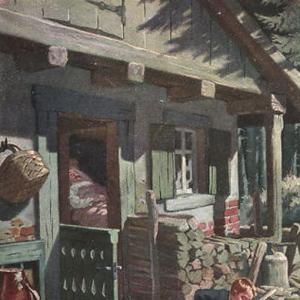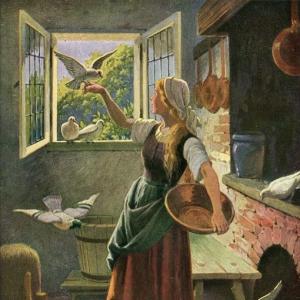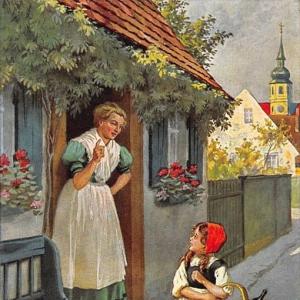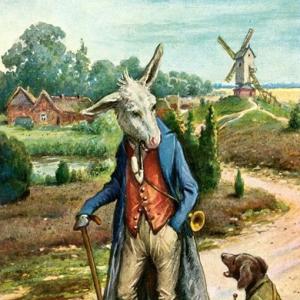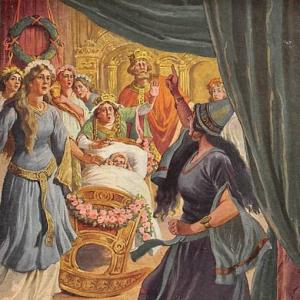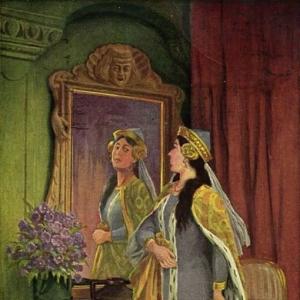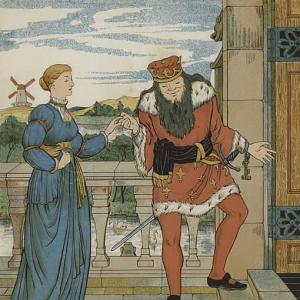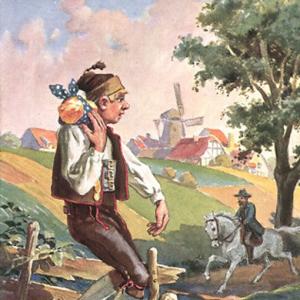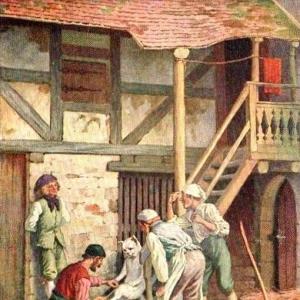Reading time: 4 min
There was once a woman who lived with her daughter in a beautiful cabbage-garden. And there came a rabbit and ate up all the cabbages. At last said the woman to her daughter, „Go into the garden, and drive out the rabbit.“ – „Shoo! shoo!“ said the maiden. „Don’t eat up all our cabbages, little rabbit!“ – „Come, maiden,“ said the rabbit, „sit on my tail and go with me to my rabbit-hutch.“
But the maiden would not. Another day, back came the rabbit, and ate away at the cabbages, until the woman said to her daughter, „Go into the garden, and drive away the rabbit.“ – „Shoo! shoo!“ said the maiden. „Don’t eat up all our cabbages, little rabbit!“ – „Come, maiden,“ said the rabbit, „sit on my tail and go with me to my rabbit-hutch.“
But the maiden would not. Again, a third time back came the rabbit, and ate away at the cabbages, until the woman said to her daughter, „Go into the garden, and drive away the rabbit.“ – „Shoo! shoo!“ said the maiden. „Don’t eat up all our cabbages, little rabbit!“ – „Come, maiden,“ said the rabbit, „sit on my tail and go with me to my rabbit-hutch.“
And then the girl seated herself on the rabbit’s tail, and the rabbit took her to his hutch. „Now,“ said he, „set to work and cook some bran and cabbage. I am going to bid the wedding guests.“ And soon they were all collected. Would you like to know who they were? Well, I can only tell you what was told to me. all the hares came, and the crow who was to be the parson to marry them, and the fox for the clerk, and the altar was under the rainbow.
But the maiden was sad, because she was so lonely. „Get up! get up!“ said the rabbit, „the wedding folk are all merry.“ But the bride wept and said nothing, and the rabbit went away, but very soon came back again. „Get up! get up!“ said he, „the wedding folk are waiting.“ But the bride said nothing, and the rabbit went away.
Then she made a figure of straw, and dressed it in her own clothes, and gave it a red mouth, and set it to watch the kettle of bran, and then she went home to her mother. Back again came the rabbit, saying, „Get up! get up!“ and he went up and hit the straw figure on the head, so that it tumbled down. And the rabbit thought that he had killed his bride, and he went away and was very sad.
 Learn languages. Double-tap on a word.Learn languages in context with Childstories.org and Deepl.com.
Learn languages. Double-tap on a word.Learn languages in context with Childstories.org and Deepl.com.Backgrounds
Interpretations
Adaptions
Summary
Abstract
Linguistics
„The Hare’s Bride“ is a lesser-known German fairy tale collected by the Brothers Grimm in their anthology „Grimms‘ Fairy Tales.“ The story is also sometimes referred to as „The Hare and the Hedgehog.“ It tells the tale of a young girl who outsmarts a hare that tries to make her his bride. Here are some key background elements of the tale.
The Brothers Grimm: Jacob and Wilhelm Grimm were German scholars, linguists, and cultural researchers who collected and published European folktales in the 19th century. Their goal was to preserve the rich oral tradition of storytelling found throughout Europe. Their collection, „Grimms‘ Fairy Tales,“ is considered one of the most influential works in the field of folklore. The brothers compiled and published a collection of over 200 fairy tales and legends during the early 19th century. Their work aimed to preserve the rich oral storytelling tradition of Germany and Europe and contributed significantly to the development of folklore studies.
Origins and influences: „The Hare’s Bride“ is believed to have originated from the German oral tradition, passed down through generations of storytelling. The tale shares themes and motifs with other folktales and fairy tales, such as the idea of cleverness and wit being used to escape an undesirable situation, as well as the concept of a young girl outsmarting a supernatural or powerful being. The Brothers Grimm collected the stories from various sources, including friends, acquaintances, and printed materials. As part of their efforts, they sought to capture the cultural essence and moral lessons embedded in these narratives. Their fairy tales often include fantastical elements, such as talking animals and magical occurrences, and typically feature a moral or cautionary lesson.
Structure and plot: The story follows a young girl who is captured by a hare that intends to make her his bride. The hare brings her to his home and instructs her to cook dinner for their wedding guests. However, the girl, who does not want to marry the hare, devises a clever plan to escape. She asks the hare to gather water for the meal, and while he is away, she uses a straw doll dressed in her clothes to trick the hare into thinking she is still there. The girl then runs away, and the hare is unable to find her.
Themes and motifs: „The Hare’s Bride“ explores several themes and motifs common to many folktales and fairy tales: The story highlights the importance of using one’s intelligence and resourcefulness to overcome challenges and escape dangerous situations. The tale emphasizes the use of trickery and deception as a means of escaping an unwanted situation, as the girl uses a straw doll to fool the hare and make her escape. The story can be seen as a celebration of female empowerment, with the young girl using her intelligence and resourcefulness to outwit the hare and avoid an unwanted marriage.
Morals and lessons: The tale imparts valuable life lessons about the importance of cleverness, wit, and resourcefulness, as well as the power of a young girl to overcome challenges and take control of her own destiny.
In summary, „The Hare’s Bride“ is a lesser-known Grimm’s fairy tale that focuses on the themes of cleverness, wit, and female empowerment. The story showcases the power of a young girl to take control of her own destiny and escape an unwanted situation through intelligence and resourcefulness. Although „The Hare’s Bride“ is not as well-known as other Grimm fairy tales, like „Cinderella“ or „Snow White,“ it still shares the same themes of personal autonomy, cunning, and consequences of actions found in many of their stories. The tale also embodies the Brothers Grimm’s focus on preserving folklore and presenting narratives that reflect cultural values and beliefs.
„The Hare’s Bride“ offers several interpretations that can be drawn from its narrative and symbolism. Here are a few possible interpretations:
Personal autonomy and choice: The story shows the importance of personal autonomy and making choices for oneself. The maiden initially refuses the rabbit’s invitations, asserting her independence. However, when she finally accepts, she realizes the situation isn’t right for her and takes action to escape, reclaiming her autonomy.
Deception and cunning: The maiden uses her intelligence and cunning to escape from the unwanted marriage. By creating the straw figure, she deceives the rabbit, ensuring her safe return home. This could be seen as a message that resourcefulness and quick thinking can be helpful in difficult situations.
Innocence and vulnerability: The tale can be seen as a cautionary story about the vulnerability of innocence. The naive maiden gets lured into an unfamiliar situation, only to find herself trapped in a marriage she doesn’t want. The story serves as a warning to be cautious and vigilant in unfamiliar circumstances.
Nature and harmony: The story features various animals, such as hares, a crow, and a fox, and takes place in a cabbage garden and under a rainbow. This imagery can represent the harmony and balance in nature. The rabbit’s desire to marry the maiden may symbolize an attempt to bridge the gap between the human and animal worlds, though it ultimately fails.
The consequences of actions: The rabbit, driven by its desire to marry the maiden, loses her when she escapes. In the end, the rabbit is left heartbroken and grieving for what it believes to be its deceased bride. This can serve as a reminder that actions have consequences and may not always result in the desired outcome.
Cleverness and resourcefulness: The tale highlights the importance of using intelligence and resourcefulness to overcome challenges and escape dangerous situations. This interpretation emphasizes the power of wit and cunning in navigating life’s difficulties.
Trickery and deception: The story emphasizes the use of trickery and deception as a means of escaping an unwanted situation. The girl’s ability to outsmart the hare by using a straw doll to fool him suggests that sometimes deception can be necessary to protect oneself or achieve a desired outcome.
Female empowerment: The story can be seen as a celebration of female empowerment, with the young girl using her intelligence and resourcefulness to outwit the hare and avoid an unwanted marriage. This interpretation underscores the power of women to take control of their own destinies and overcome societal expectations.
Overcoming adversity: „The Hare’s Bride“ can be read as a story about overcoming adversity, as the young girl faces a difficult situation and finds a way to escape it. This interpretation encourages readers to be resilient and resourceful in the face of challenges.
The power of the individual: The story demonstrates the power of the individual to shape their own fate, as the girl is able to use her intelligence and resourcefulness to escape the hare’s clutches. This interpretation invites readers to consider the ways in which they can take control of their own lives and determine their own destinies.
The danger of deception: While the girl’s deception ultimately leads to her escape, the story also highlights the potential danger of deception. The hare’s initial capture of the girl may be seen as a form of deception, and her escape only becomes necessary due to this deception. This interpretation invites readers to consider the potential consequences of deception, even when it is used for a seemingly justifiable purpose.
In summary, „The Hare’s Bride“ offers various interpretations, each providing a different perspective on the story’s themes and lessons. The tale’s multifaceted nature allows for a rich and engaging reading experience, inviting readers to reflect on its themes and connect them to their own lives.
„The Hare’s Bride“ is a lesser-known fairy tale by the Brothers Grimm, and as such, it has not seen as many adaptations as some of the more popular tales. However, there are some creative works and adaptations that have been inspired by or reference the story. Here are a few examples.
Anthologies: „The Hare’s Bride“ has been included in various anthologies of Brothers Grimm fairy tales, often accompanied by illustrations that bring the story to life. These editions offer readers a chance to discover and appreciate the lesser-known tale within the context of the larger collection.
Films: In 1987, director Aleksandr Rou adapted the story into a Soviet-era film titled „The Hare’s Bride.“ The film tells the story of a young prince who sets out on a journey to marry a princess, but ends up marrying her servant who is transformed into a hare. The film follows the prince’s journey to break the spell and turn his bride back into a human.
Television: The fairy tale has been adapted into several episodes of television series aimed at children, including „Jim Henson’s The Storyteller“ and „Faerie Tale Theater.“
Literature: „The Hare’s Bride“ has been adapted into various forms of literature, including children’s books and short stories. In 2013, author Ursula Vernon released a novel titled „Castle Hangnail,“ which is a modern retelling of the story.
Opera: In 2007, composer Giselher Klebe adapted the story into an opera titled „Die Braut des Hase“ (The Hare’s Bride). The opera features a libretto by Wolfgang Willaschek and premiered at the Mainz State Theater in Germany.
Theater: While it may not be as frequently adapted for the stage as some other Grimm stories, „The Hare’s Bride“ has occasionally been incorporated into storytelling performances or theatrical productions that showcase multiple fairy tales. These performances aim to introduce audiences to lesser-known tales and emphasize the story’s themes of cleverness, resourcefulness, and female empowerment. In 2019, choreographer Eric Gauthier created a ballet adaptation of „The Hare’s Bride“ titled „Hase und Hase“ (Hare and Hare). The ballet features music by Lera Auerbach and premiered at the Theaterhaus Stuttgart in Germany.
Folklore studies and analysis: The tale has been discussed and analyzed within the context of folklore studies, with scholars examining its themes, motifs, and possible origins. These academic discussions contribute to a deeper understanding of the tale and its significance within the larger body of Grimm’s fairy tales.
Art and illustrations: Some artists have created artwork inspired by „The Hare’s Bride,“ either as standalone pieces or as part of larger projects related to Grimm’s fairy tales. These illustrations can help to visualize the story’s characters, setting, and key moments, adding an additional dimension to the narrative.
„The Hare’s Bride“ has been adapted into various forms of media, reflecting its enduring popularity and appeal. These adaptations showcase the story’s themes and motifs in different ways, highlighting its rich and complex narrative. While „The Hare’s Bride“ may not have as many adaptations as some of the more famous Grimm tales, these examples demonstrate that the story still holds creative appeal and continues to inspire artists and storytellers. Its themes of cleverness, resourcefulness, and female empowerment remain relevant, and its inclusion in various collections ensures that it continues to reach new audiences.
„The Hare’s Bride“ is a fairy tale by the Brothers Grimm about a woman and her daughter who live in a beautiful cabbage garden. A rabbit continually comes to eat their cabbages, and the woman sends her daughter to chase it away. Each time, the rabbit invites the maiden to sit on its tail and go to its hutch, but she refuses. On the third occasion, she accepts the rabbit’s invitation.
At the hutch, the rabbit instructs the girl to cook bran and cabbage for their wedding and proceeds to invite the guests, which include various animals. The crow is to be the parson, the fox the clerk, and the altar is set under a rainbow. The maiden, feeling lonely, does not join the festivities and cries instead.
The rabbit repeatedly urges the girl to join the wedding, but she remains silent. Eventually, she creates a straw figure dressed in her clothes, gives it a red mouth, and places it by the kettle of bran. She then returns home to her mother. The rabbit, believing the straw figure is his bride, accidentally knocks it down and thinks he has killed her. Devastated, the rabbit leaves, feeling extremely sad.
„The Hare’s Bride“ is a lesser-known fairy tale from the Brothers Grimm that tells the story of a young girl who cleverly outsmarts a hare that intends to make her his bride. The tale begins with a young girl who goes to the field to collect vegetables for her family. While she is in the field, a hare approaches her and demands that she come with him to become his bride. The girl, not wanting to marry the hare, tries to refuse, but the hare insists and takes her to his home.
At the hare’s house, he instructs the girl to prepare dinner for their wedding guests. The girl, still not wanting to marry the hare, devises a plan to escape. She asks the hare to fetch some water for the meal, and while he is gone, she creates a straw doll dressed in her own clothes. She places the straw doll in the window to trick the hare into believing she is still there.
When the hare returns and sees the straw doll, he believes it is the girl and speaks to it, but receives no response. Frustrated, the hare goes back to fetch more water, giving the girl an opportunity to run away. The hare eventually discovers the deception and chases after the girl, but he is unable to catch her. The girl escapes and returns safely to her family. „The Hare’s Bride“ emphasizes themes of cleverness, resourcefulness, and female empowerment, as the young girl uses her wit and ingenuity to outsmart the hare and escape an unwanted marriage.
The fairy tale „The Hare’s Bride“ by the Brothers Grimm presents a simple yet intriguing narrative that can be analyzed from various linguistic perspectives. Here’s an analysis focusing on several key linguistic features:
Repetition and Parallel Structure
One of the most notable linguistic features in this story is the use of repetition and parallel structure. The narrative is segmented into repetitive scenes where the rabbit repeatedly returns to eat the cabbages, and the maiden is instructed to chase him away. This repetition not only emphasizes the persistence of the rabbit but also sets up an expectation for the reader that eventually breaks when the maiden decides to go with the rabbit.
Dialogue and Direct Speech
The story employs direct speech extensively. Dialogue is crafted in a simple, repetitive manner which is characteristic of oral traditions and fairy tales, aiding memorability and oral recitation. The rabbit’s invitation, „Come, maiden, sit on my tail and go with me to my rabbit-hutch,“ is repeated verbatim, contributing to the rhythmic and formulaic structure typical in fairy tales.
Tone and Mood
The tone is initially whimsical and playful, with elements of fantasy highlighted by the anthropomorphic rabbit who speaks and invites the maiden on an adventure. However, the mood shifts as the story progresses; what begins as a seemingly innocent tale takes on a darker undertone, especially when the maiden feels lonely and later deceives the rabbit with the straw figure. This shift plays into the moral complexity often found in Grimm tales.
Symbolism and Imagery
Symbolism is prevalent throughout the tale. The cabbage-garden signifies a simple, rural life and sustenance, which is disrupted by the rabbit, embodying temptation or the unknown. The rabbit’s hutch, on the other hand, symbolizes a strange and foreign world into which the maiden is unwillingly drawn.
Cultural and Thematic Elements
The cultural elements in the tale, such as the use of animals like rabbits, crows, and foxes, are common in European folklore, often representing various human traits or societal roles. Thematically, the tale can be interpreted as a commentary on autonomy, temptation, and cleverness. The maiden’s ultimate act of creating a straw figure to deceive the rabbit reflects her cleverness and desire for freedom.
Syntax and Phrasing
The syntax of the story is straightforward, with simple sentence structures that align with the fairy tale tradition aimed primarily at children. This simplicity aids in understanding and contributes to the timelessness of the story.
Conclusion
„The Hare’s Bride“ uses linguistic elements common to fairy tales—repetition, direct speech, symbolism, and simple syntax—to weave a story that is both enchanting and thought-provoking. Through its linguistic construction, it engages readers in a narrative that juxtaposes innocence and cunning, exploring themes of agency and deception in a mythical setting.
Information for scientific analysis
Fairy tale statistics | Value |
|---|---|
| Number | KHM 66 |
| Aarne-Thompson-Uther-Index | ATU Typ 311 |
| Translations | DE, EN, DA, ES, FR, PT, IT, JA, NL, PL, RU, TR, ZH |
| Readability Index by Björnsson | 16.8 |
| Flesch-Reading-Ease Index | 91.4 |
| Flesch–Kincaid Grade-Level | 3 |
| Gunning Fog Index | 4.9 |
| Coleman–Liau Index | 6.7 |
| SMOG Index | 5.9 |
| Automated Readability Index | 1.7 |
| Character Count | 2.279 |
| Letter Count | 1.672 |
| Sentence Count | 43 |
| Word Count | 437 |
| Average Words per Sentence | 10,16 |
| Words with more than 6 letters | 29 |
| Percentage of long words | 6.6% |
| Number of Syllables | 543 |
| Average Syllables per Word | 1,24 |
| Words with three Syllables | 9 |
| Percentage Words with three Syllables | 2.1% |
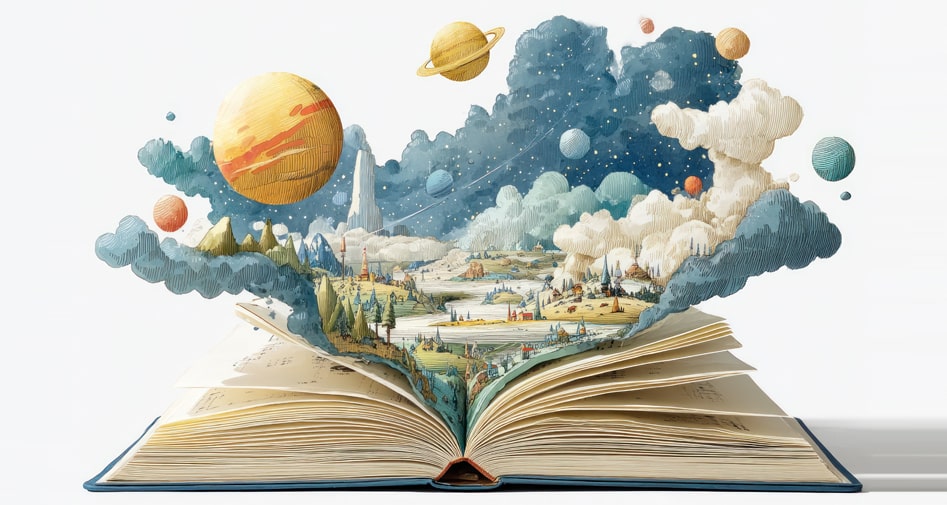
 Facebook
Facebook  Whatsapp
Whatsapp  Messenger
Messenger  Telegram
Telegram Reddit
Reddit